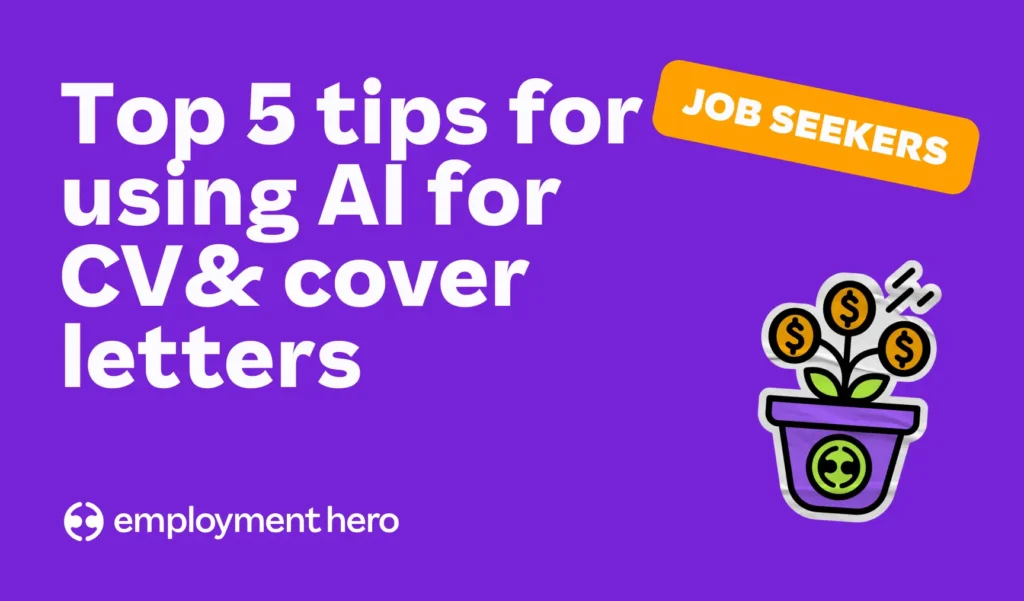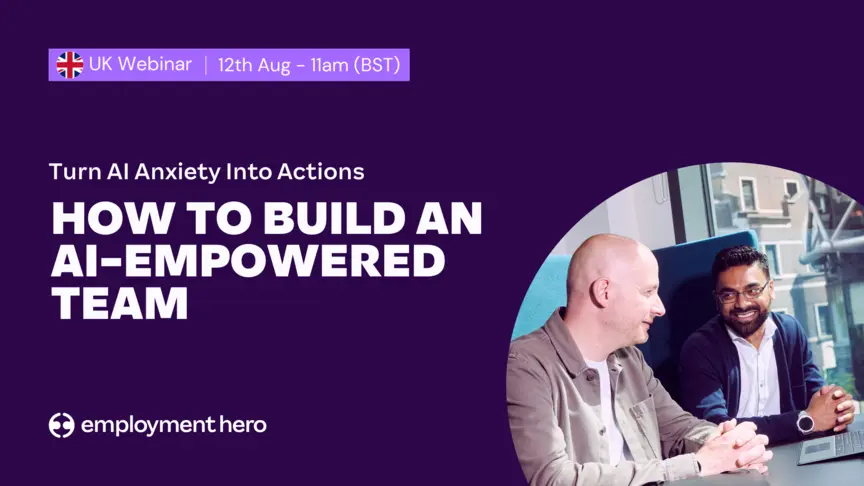Top 5 tips for using AI for CV & cover letters
Job hunting isn’t always easy. Regardless of if you’re applying for your first job or are a seasoned professional looking for a new challenge, creating a compelling resume can be a bit of a headache. This is when it comes in handy to know some tips for creating a CV.
-
Rebecca DiCioccio

Contents
Job hunting isn’t always easy. Regardless of if you’re applying for your first job or are a seasoned professional looking for a new challenge, creating a compelling resume can be a bit of a headache. This is when it comes in handy to know some tips for creating a CV.
And let’s be real, perfecting, formatting and writing tailored cover letters for each role is time consuming. This is where Artificial Intelligence (AI) comes in.
If you’re wondering how to use AI for CV writing, you’re in the right place. Artificial intelligence has transformed the way jobseekers approach applications, from eliminating writer’s block to formatting to proof reading, these tools can save you time and errors.
Keep reading if you want to learn our top 5 tips for creating a CV using AI.
Why jobseekers are turning to AI for CVs and cover letters
The employment landscape is changing and this means that the way we apply for jobs needs to adapt too. Like many changes in today’s world, artificial intelligence is playing a part.
Writing a resume and cover letter used to be a task that involved hours staring at a blank page, second-guessing wording and endlessly tweaking formatting… and still not knowing if it was right or not. Now, AI-powered writing tools are making the process faster, easier and more effective.
This matters most for those actively job hunting, where efficiency and impact can make all the difference. By using tools for resumes and cover letters, you can produce professional, tailored applications that align with job requirements, without getting bogged down in the technical details. Instead of worrying about layout or wording, you can focus on highlighting your skills and preparing for interviews.
1: Choose the right AI tool for your needs
The good news is, when it comes to using AI for CV writing, there are loads of tools available, but this does make it hard to know which tool to use. And the first tip for writing a CV, is choose the right tool.
There is no one-size-fits-all approach to selecting a tool and it depends on what you’re hoping to improve and streamline in your resume creation process. But here are a few things to consider when looking at AI tools.
Free vs paid tools: what to look for
There are tools for every budget and you don’t need to spend money to create a professional resume using artificial intelligence. This makes it easy to create a professional CV using AI for free. Tools such as ChatGPT and Gemini have the ability to provide simple templates, cover letter drafts, proof reading and formatting. It’s important to remember that free tools often come with limitations.
Paid versions of tools, on the other hand, typically include more advanced features like role-specific prompts, tone adjustments and the ability to export polished, ATS-friendly documents. For jobseekers applying to competitive roles, these extras can be worth the investment but it will depend on your budget and financial situation.
Writing vs formatting vs keyword-optimisation features
Not all AI tools are built the same. Some focus heavily on writing support, helping you phrase your responsibilities and achievements clearly, while others specialise in formatting, ensuring your resume layout looks professional. The most effective solutions combine both, with keyword optimisation features to help your application pass through Applicant Tracking Systems (ATS).
When evaluating tools, look for those that:
- Generate ATS-friendly formatting (simple, clean layouts without tables or images).
- Offer suggestions tailored to your industry and role.
- Allow you to adjust tone and style to match the job description.
- Provide cover letter support alongside resume creation for a consistent application.
2: Use strong prompts to get better outputs
One of the most important things to learn when figuring out how to use AI for CVs or cover letters is that your results are only as good as the information you provide. Artificial intelligence works best when it’s guided by clear, role-specific input. That means including details like:
- Job title
- Industry
- Required skills
- Key responsibilities from the job ad
Giving vague instructions like “write me a resume” or “create a cover letter” will often result in generic, impersonal results that won’t stand out to recruiters. But by supplying the right context, you’ll receive tailored, professional outputs that highlight your experience in the most relevant way.
Example prompts for resumes
- ‘Create a two-page resume for a marketing manager with five years of experience in digital campaigns, SEO, and team leadership. Highlight achievements with metrics and keep formatting ATS-friendly.’
- ‘Write bullet points for a resume under the role of software engineer, focusing on cloud solutions, Python, and collaboration with cross-functional teams.’
Example prompts for cover letters
- ‘Draft a cover letter for an entry-level HR assistant role. Emphasise organisational skills, knowledge of HR software, and a passion for helping employees succeed.’
- ‘Write a professional yet friendly cover letter for a senior sales manager position. Focus on exceeding sales targets, building client relationships, and leadership experience.’
3: Tailor your output to beat AI screening tools
Artificial intelligence isn’t just something you can use to help streamline your application process, AI is used at work for lots of different purposes and it can also help recruiters. So keep in mind that before a recruiter even sees your application, it has probably been scanned by an ATS or an AI-based filter. These tools help employers manage large volumes of applicants by automatically ranking resumes and cover letters against the job description.
That’s why tailoring your AI-generated content is critical, because even the most well-written application won’t matter if the system filters it out.
So, do companies use AI detectors for cover letters and CVs? Yes, many do. While not every employer uses advanced filters, an increasing number rely on AI-driven tools to check for relevance, keywords and formatting. This means your application needs to be both human-friendly and machine-readable.
Why keywords and formatting matter
ATS tools scan for specific keywords that match the job description, such as ‘project management’, ‘budget forecasting’, or ‘JavaScript’. If your resume doesn’t include these, you may never make it to the shortlisting stage.
Formatting is equally important, complex designs, tables, or graphics can confuse ATS systems, leading to missing or jumbled information.
Actionable tips to optimise your resume and cover letter
- Mirror the job advert language: Use the same key skills and terminology listed in the description.
- Keep it simple: Stick to clear headings, bullet points, and standard fonts. Avoid images, icons, and tables.
- Customise each application: A generic AI-generated resume won’t perform well. Adjust your content for every role you apply to.
- Test your resume: Some tools (including our EH Jobs platform) allow you to check ATS compatibility before submitting.
By tailoring your output this way, you improve your chances of getting through automated filters and into the hands of a real hiring manager.
4: Don’t skip human editing and personalisation
One of the most important tips for creating a CV using AI is not to underestimate the importance of human touch. While tools can give you a head start and lead you in the right direction, it can’t replace your voice, personality and lived experiences. This is why editing is essential.
AI-generated resumes and cover letters may look polished on the surface, but they often contain generic phrases, overused buzzwords or inaccuracies if the inputs weren’t specific enough. Taking the time to review, fact-check, and personalise your application ensures it feels authentic and credible.
How to personalise AI drafts effectively
- Double-check accuracy: Make sure job titles, dates, and achievements are correct. AI can sometimes ‘hallucinate’ or make assumptions.
- Add real impact: Include metrics, stories, or unique examples that reflect your actual achievements. For instance, ‘Increased sales by 30% in Q2’ sounds far stronger than ‘Responsible for improving sales’.
- Adjust tone and style: Keep it professional, but let your enthusiasm for the role come through. Tailoring the tone to your industry can help—for example, friendly and approachable for customer service, or concise and authoritative for finance.
- Show your personality: Use artificial intelligence as a base, but weave in sentences that feel true to your communication style. Recruiters want to get a sense of the person behind the application.
The risks of over-automation
When jobseekers rely too heavily on tools, the end result can feel robotic, repetitive, or disconnected from who they really are. Recruiters can spot when cover letters lack genuine human touch and this can hurt your chances of making a strong impression. Remember: employers aren’t just hiring skills, they’re hiring people.
5: Test, refine and track results
Just like in any other area of job searching, success with AI-generated applications comes from testing and improving over time. Your first draft doesn’t have to be your final version. Instead, think of artificial intelligenceI as a tool that helps you create multiple variations quickly, so you can see what resonates best with employers.
Experiment with different versions
Try adjusting prompts, keywords, or even the tone of your applications. For example, you might create one resume that emphasises technical expertise and another that highlights leadership achievements, then see which approach generates more interview invitations. For cover letters, experiment with different levels of formality to match the company culture.
Track your results
The best way to know what’s working is to track your outcomes. Pay attention to which applications result in call-backs or interviews, and use that feedback to refine your future applications. If you’re applying to a high volume of roles, consider keeping a simple spreadsheet or using a job search tool to stay organised.
Using AI the smart way to boost your job applications
Artificial intelligence is changing the way jobseekers and recruiters approach hiring. And when used thoughtfully, it can be a powerful tool. By choosing the right tool, writing strong prompts, tailoring your output for ATS, adding personal touches, and testing what works, you can transform the job application process from stressful to strategic.
The key takeaway? Artificial intelligence should be seen as a support system, not a shortcut. It can help you save time, overcome writer’s block, and polish your applications, but your unique experiences, achievements, and personality are what truly make your resume and cover letters stand out.
Ready to put these strategies into action? Try our AI-powered EH Jobs platform to create your professional CV in minutes and take the next step toward landing your dream role with confidence..
Related Resources
-
 Read more: A beginner’s guide to getting started with AI at work
Read more: A beginner’s guide to getting started with AI at workA beginner’s guide to getting started with AI at work
Explore how to use AI at work with this beginner-friendly guide. Learn how AI can improve processes, increase productivity and…
-
 Read more: The 7 Best AI Productivity Tools to Boost Workplace Performance
Read more: The 7 Best AI Productivity Tools to Boost Workplace PerformanceThe 7 Best AI Productivity Tools to Boost Workplace Performance
In today’s fast-paced world, businesses are constantly seeking new ways to boost productivity and stay ahead. For UK Small-to-Medium Enterprises…




















